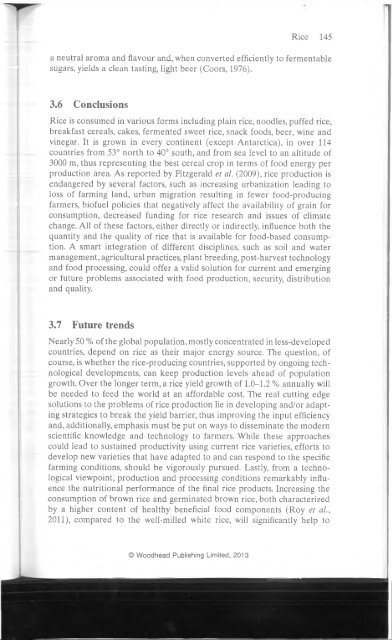Arendt und Zannini - 2013 - Cereal grains for the food and beverage industries
Arendt und Zannini - 2013 - Cereal grains for the food and beverage industries
Arendt und Zannini - 2013 - Cereal grains for the food and beverage industries
Create successful ePaper yourself
Turn your PDF publications into a flip-book with our unique Google optimized e-Paper software.
Rice 145<br />
a neutral aroma <strong>and</strong> flavour <strong>and</strong>, when converted efficiently to fermentable<br />
sugars, yields a clean tasting, light beer (Coors, 1976).<br />
3.6 Conclusions<br />
Rice is consumed in various <strong>for</strong>ms including plain rice, noodles, puffed rice,<br />
breakfast cereals, cakes, fermented sweet rice, snack <strong>food</strong>s, beer, wine <strong>and</strong><br />
vinegar. It is grown in every continent (except Antarctica), in over 114<br />
countries from 53° north to 40° south, <strong>and</strong> from sea level to an altitude of<br />
3000 m, thus representing <strong>the</strong> best cereal crop in terms of <strong>food</strong> energy per<br />
production area. As reported by Fitzgerald et al. (2009), rice production is<br />
endangered by several factors, such as increasing urbanization leading to<br />
loss of farming l<strong>and</strong>, urban migration resulting in fewer <strong>food</strong>-producing<br />
farmers, biofuel policies that negatively affect <strong>the</strong> availability of grain <strong>for</strong><br />
consumption, decreased f<strong>und</strong>ing <strong>for</strong> rice research <strong>and</strong> issues of climate<br />
change. All of <strong>the</strong>se factors, ei<strong>the</strong>r directly or indirectly, influence both <strong>the</strong><br />
quantity <strong>and</strong> <strong>the</strong> quality of rice that is available <strong>for</strong> <strong>food</strong>-based consumption.<br />
A smart integration of different disciplines, such as soil <strong>and</strong> water<br />
management, agricultural practices, plant breeding, post-harvest technology<br />
<strong>and</strong> <strong>food</strong> processing, could offer a valid solution <strong>for</strong> current <strong>and</strong> emerging<br />
or future problems associated with <strong>food</strong> production, security, distribution<br />
<strong>and</strong> quality.<br />
3.7 Future trends<br />
Nearly 50 % of <strong>the</strong> global population, mostly concentrated in less-developed<br />
countries, depend on rice as <strong>the</strong>ir major energy source. The question, of<br />
course, is whe<strong>the</strong>r <strong>the</strong> rice-producing countries, supported by ongoing technological<br />
developments, can keep production levels ahead of population<br />
growth. Over <strong>the</strong> longer term, a rice yield growth of 1.0-1.2 % annually will<br />
be needed to feed <strong>the</strong> world at an af<strong>for</strong>dable cost. The real cutting edge<br />
solutions to <strong>the</strong> problems of rice production lie in developing <strong>and</strong>/or adapting<br />
strategies to break <strong>the</strong> yield barrier, thus improving <strong>the</strong> input efficiency<br />
<strong>and</strong>, additionally, emphasis must be put on ways to disseminate <strong>the</strong> modern<br />
scientific knowledge <strong>and</strong> technology to farmers. While <strong>the</strong>se approaches<br />
could lead to sustained productivity using current rice varieties, ef<strong>for</strong>ts to<br />
develop new varieties that have adapted to <strong>and</strong> can respond to <strong>the</strong> specific<br />
farming conditions, should be vigorously pursued. Lastly, from a technological<br />
viewpoint, production <strong>and</strong> processing conditions remarkably influence<br />
<strong>the</strong> nutritional per<strong>for</strong>mance of <strong>the</strong> final rice products. Increasing <strong>the</strong><br />
consumption of brown rice <strong>and</strong> germinated brown rice, both characterized<br />
by a higher content of healthy beneficial <strong>food</strong> components (Roy et ai,<br />
2011), compared to <strong>the</strong> well-milled white rice, will significantly help to<br />
© Woodhead Publishing Limited, <strong>2013</strong>

















